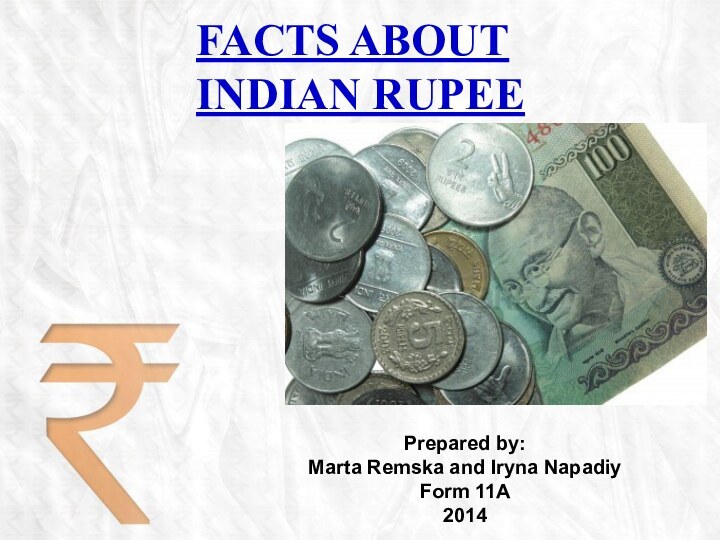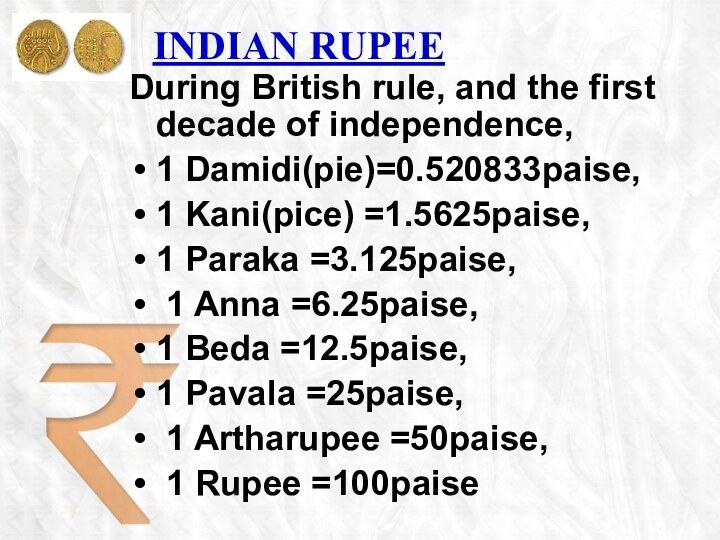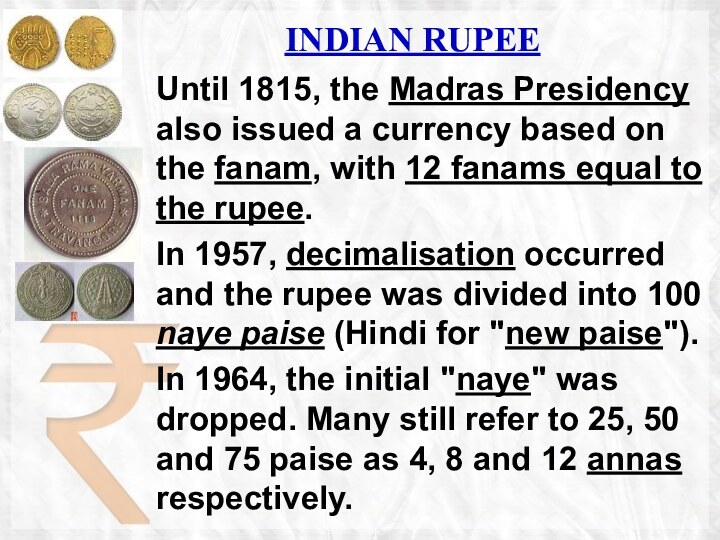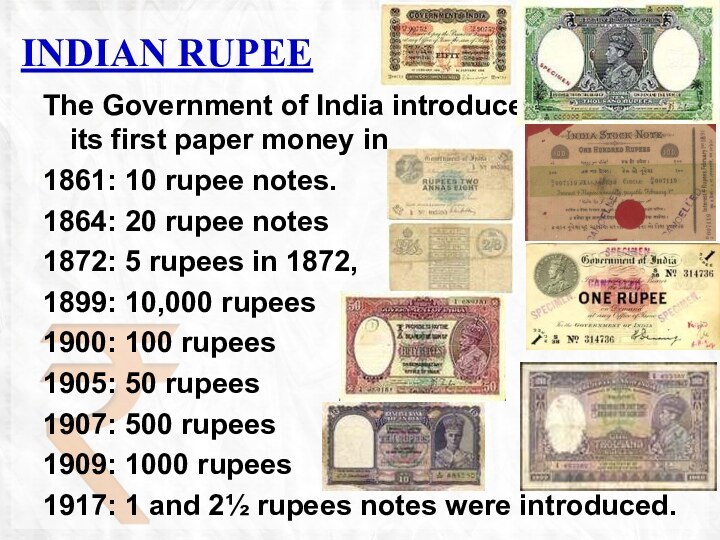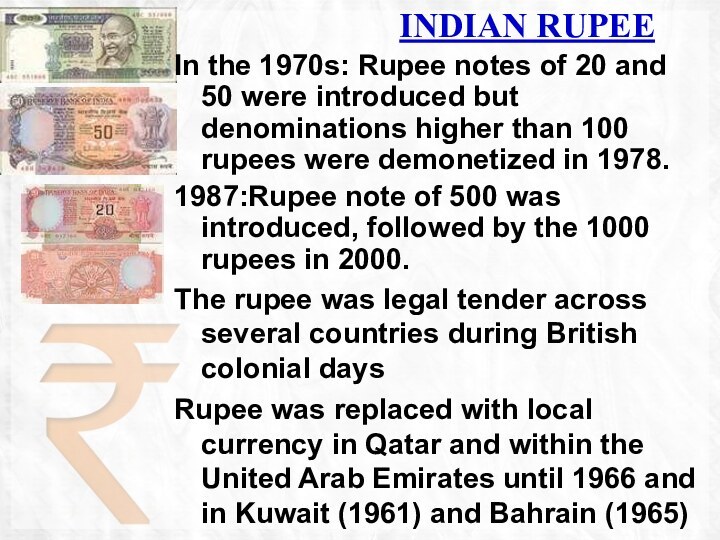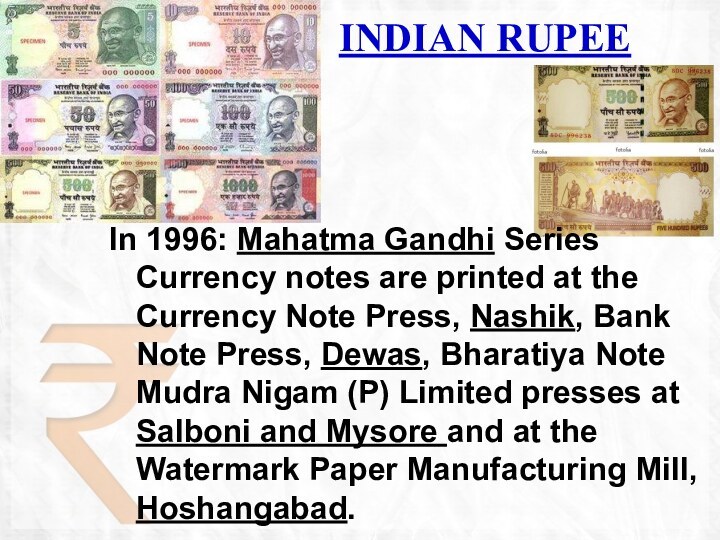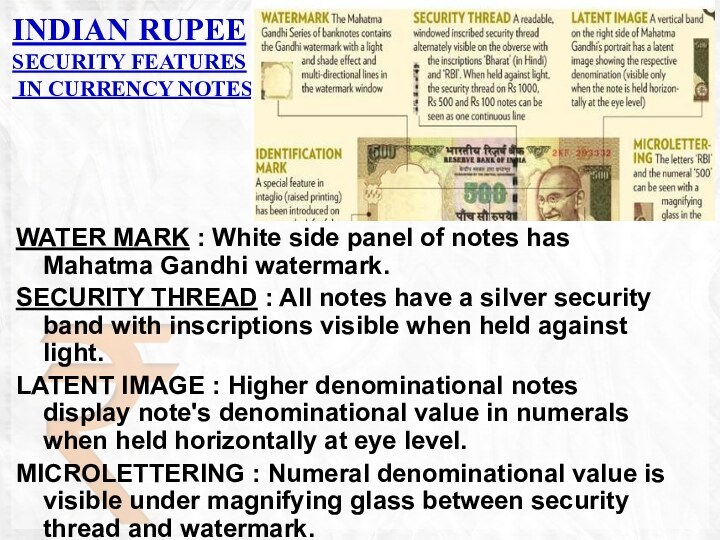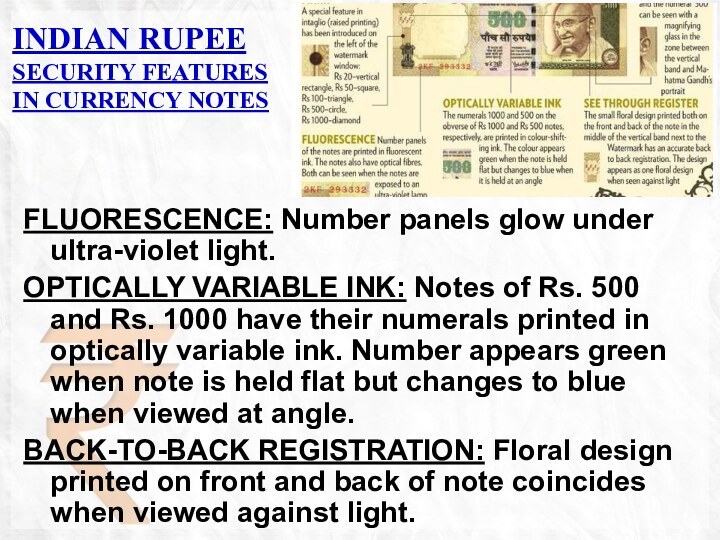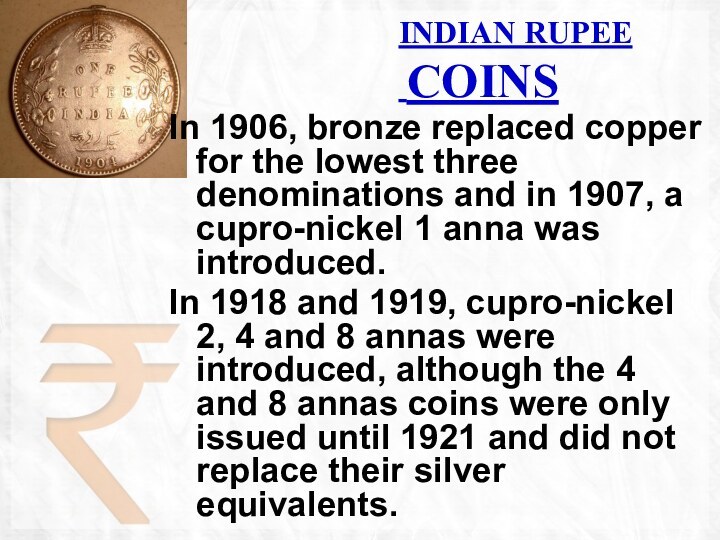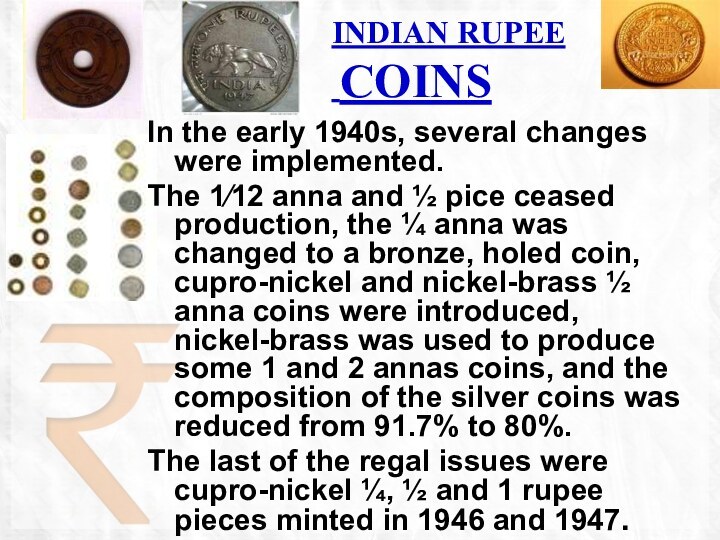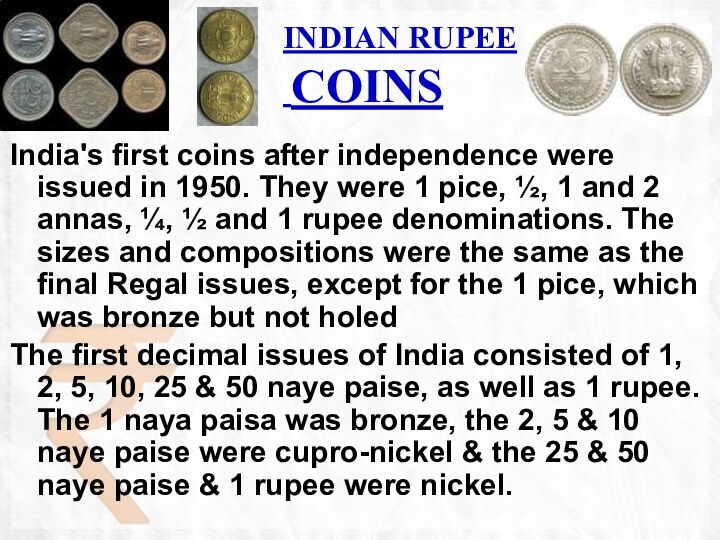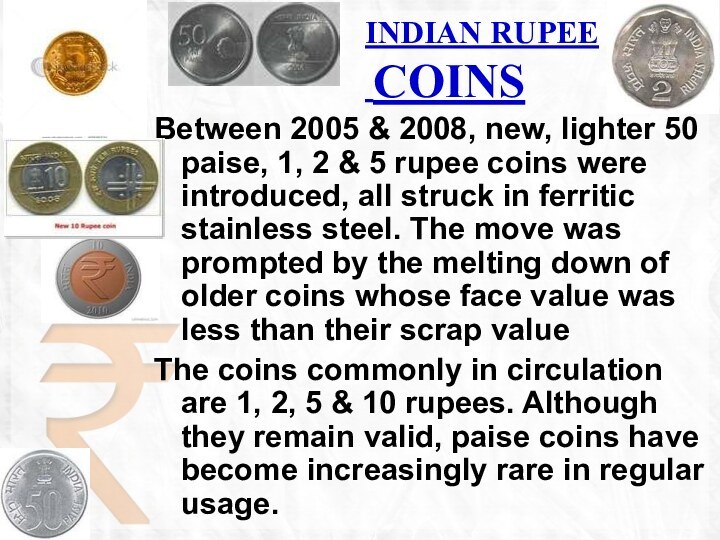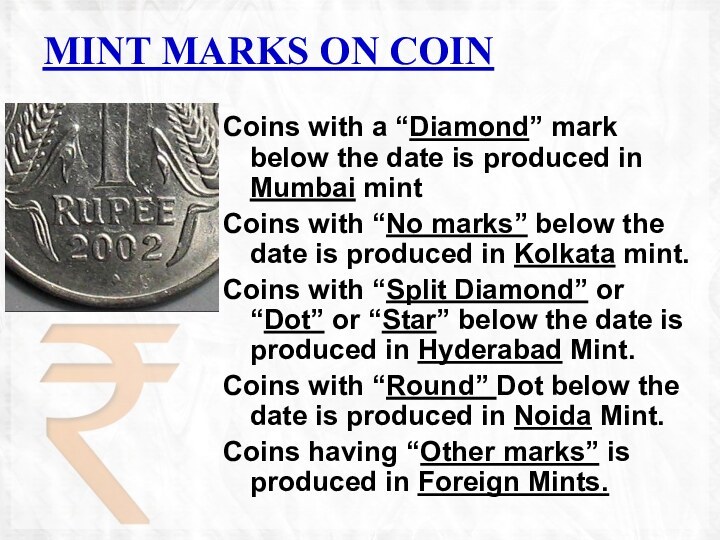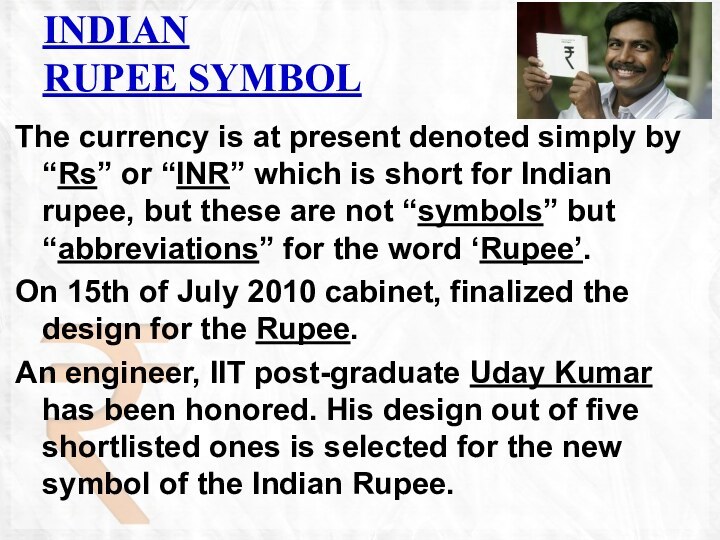Слайд 2
BIRTH OF RUPEE
* The first RUPEE was introduced
by Sher Shah Suri (1486-1545) based on a ratio
of 40 copper pieces (paisa) per rupee.
* The name was derived from the Sanskrit word RAUPYAKAM, meaning Silver.
Слайд 3
INDIAN RUPEE
During British rule, and the first decade
of independence,
1 Damidi(pie)=0.520833paise,
1 Kani(pice) =1.5625paise,
1 Paraka
=3.125paise,
1 Anna =6.25paise,
1 Beda =12.5paise,
1 Pavala =25paise,
1 Artharupee =50paise,
1 Rupee =100paise
Слайд 4
INDIAN RUPEE
Until 1815, the Madras Presidency also issued
a currency based on the fanam, with 12 fanams
equal to the rupee.
In 1957, decimalisation occurred and the rupee was divided into 100 naye paise (Hindi for "new paise").
In 1964, the initial "naye" was dropped. Many still refer to 25, 50 and 75 paise as 4, 8 and 12 annas respectively.
Слайд 5
INDIAN RUPEE
The Government of India introduced
its first paper money
in
1861: 10 rupee notes.
1864: 20 rupee notes
1872: 5 rupees in 1872,
1899: 10,000 rupees
1900: 100 rupees
1905: 50 rupees
1907: 500 rupees
1909: 1000 rupees
1917: 1 and 2½ rupees notes were introduced.
Слайд 6
1938: The Reserve Bank of India began note
production in issuing 2, 5, 10, 100, 1000 and
10000 rupee notes, while the Government continued to issue 1 rupee notes.
After independence, new designs were introduced to remove the portrait of the King. The government continued to issue the 1 rupee note, while the Reserve Bank issued other denominations, including the 5000 and 10,000 rupee notes introduced in 1949.
Слайд 7
In the 1970s: Rupee notes of 20 and
50 were introduced but denominations higher than 100 rupees
were demonetized in 1978.
1987:Rupee note of 500 was introduced, followed by the 1000 rupees in 2000.
The rupee was legal tender across several countries during British colonial days
Rupee was replaced with local currency in Qatar and within the United Arab Emirates until 1966 and in Kuwait (1961) and Bahrain (1965)
INDIAN RUPEE
Слайд 8
India escaped coming under British sterling coinage that
became effective in 1825 because it was under the
East India Company, not the British Crown.
The earliest issues of paper rupees were
1770-1832: By the Bank of Hindustan
1773–1775:The General Bank of Bengal and Bihar established by Warren Hastings)
1784–91:The Bengal Bank.
INDIAN RUPEE
Слайд 9
In 1996: Mahatma Gandhi Series Currency notes are
printed at the Currency Note Press, Nashik, Bank Note
Press, Dewas, Bharatiya Note Mudra Nigam (P) Limited presses at Salboni and Mysore and at the Watermark Paper Manufacturing Mill, Hoshangabad.
INDIAN RUPEE
Слайд 10
Each banknote has its amount written in 17
languages (English & Hindi on the front, and 15
others on the back) illustrating the diversity of the country.
INDIAN RUPEE LANGUAGE PANELS
Слайд 11
WATER MARK : White side panel of notes
has Mahatma Gandhi watermark.
SECURITY THREAD : All notes have
a silver security band with inscriptions visible when held against light.
LATENT IMAGE : Higher denominational notes display note's denominational value in numerals when held horizontally at eye level.
MICROLETTERING : Numeral denominational value is visible under magnifying glass between security thread and watermark.
INDIAN RUPEE
SECURITY FEATURES
IN CURRENCY NOTES
Слайд 12
FLUORESCENCE: Number panels glow under ultra-violet light.
OPTICALLY VARIABLE
INK: Notes of Rs. 500 and Rs. 1000 have
their numerals printed in optically variable ink. Number appears green when note is held flat but changes to blue when viewed at angle.
BACK-TO-BACK REGISTRATION: Floral design printed on front and back of note coincides when viewed against light.
INDIAN RUPEE
SECURITY FEATURES
IN CURRENCY NOTES
Слайд 13
The three Presidencies established by the British East
India Company (Bengal, Bombay and Madras) each issued their
own coinages up to 1835. All three issued rupees together with fractions down to ⅛ and 1⁄16 rupee in silver. Madras also issued 2 rupees coins.
Copper denominations were more varied.
Bengal issued 1 pie, ½, 1 and 2 paise.
Bombay issued 1 pie, ¼, ½, 1, 1½, 2 and 4 paise.
INDIAN RUPEE
COINS
Слайд 14
INDIAN RUPEE
COINS
In Madras, there were copper
coins for 2, 4 pies, 1, 2 and 4
paisa, with the first two denominated as ½ and 1 dub or 1⁄96 and 1⁄48 rupee.
Note that Madras issued the Madras fanam until 1815.
Слайд 15
In 1835, a single coinage for the EIC
was introduced. It consisted of copper 1⁄12, ¼ and
½ anna, silver ¼, ½ and 1 rupee and gold 1 and 2 mohurs.
In 1841, silver 2 annas were added, followed by copper ½ pice in 1853. The coinage of the EIC continued to be issued until 1862, even after the Company had been taken over by the Crown.
INDIAN RUPEE
COINS
Слайд 16
INDIAN RUPEE
COINS
In 1862, coins were introduced which
are referred to as Regal issues. They bore the
portrait of Queen Victoria and the designation "India". Denominations were 1⁄12 anna, ½ pice, ¼ and ½ anna (all in copper), 2 annas, ¼, ½ and 1 rupee (silver) and 5 and 10 rupees and 1 mohur (gold).
The gold denominations ceased production in 1891 while no ½ anna coins were issued dated later than 1877.
Слайд 17
INDIAN RUPEE
COINS
In 1906, bronze replaced copper for
the lowest three denominations and in 1907, a cupro-nickel
1 anna was introduced.
In 1918 and 1919, cupro-nickel 2, 4 and 8 annas were introduced, although the 4 and 8 annas coins were only issued until 1921 and did not replace their silver equivalents.
Слайд 18
INDIAN RUPEE
COINS
In the early 1940s, several changes
were implemented.
The 1⁄12 anna and ½ pice ceased
production, the ¼ anna was changed to a bronze, holed coin, cupro-nickel and nickel-brass ½ anna coins were introduced, nickel-brass was used to produce some 1 and 2 annas coins, and the composition of the silver coins was reduced from 91.7% to 80%.
The last of the regal issues were cupro-nickel ¼, ½ and 1 rupee pieces minted in 1946 and 1947.
Слайд 19
INDIAN RUPEE
COINS
India's first coins after independence were
issued in 1950. They were 1 pice, ½, 1
and 2 annas, ¼, ½ and 1 rupee denominations. The sizes and compositions were the same as the final Regal issues, except for the 1 pice, which was bronze but not holed
The first decimal issues of India consisted of 1, 2, 5, 10, 25 & 50 naye paise, as well as 1 rupee. The 1 naya paisa was bronze, the 2, 5 & 10 naye paise were cupro-nickel & the 25 & 50 naye paise & 1 rupee were nickel.
Слайд 20
INDIAN RUPEE
COINS
In 1964, the word naya(e) was
removed from all the coins. Between 1964 & 1967,
aluminum 1, 2, 3, 5 & 10 paise were introduced. In 1968, nickel-brass 20 paise were introduced, replaced by aluminum coins in 1982.
Between 1972 & 1975, cupro-nickel replaced nickel in the 25 & 50 paise as well as the 1 rupee. In 1982, cupro-nickel 2 rupees coins were introduced. In 1988, stainless steel 10, 25 & 50 paise were introduced, followed by 1 & 5 rupee coins in 1992.
Слайд 21
INDIAN RUPEE
COINS
Between 2005 & 2008, new, lighter
50 paise, 1, 2 & 5 rupee coins were
introduced, all struck in ferritic stainless steel. The move was prompted by the melting down of older coins whose face value was less than their scrap value
The coins commonly in circulation are 1, 2, 5 & 10 rupees. Although they remain valid, paise coins have become increasingly rare in regular usage.
Слайд 22
MINT MARKS ON COIN
Coins with a “Diamond” mark
below the date is produced in Mumbai mint
Coins with
“No marks” below the date is produced in Kolkata mint.
Coins with “Split Diamond” or “Dot” or “Star” below the date is produced in Hyderabad Mint.
Coins with “Round” Dot below the date is produced in Noida Mint.
Coins having “Other marks” is produced in Foreign Mints.
Слайд 23
CURRENCY SYMBOL
Most currencies in the world have no
specific symbol.
The British pound (£) dates back to
the 8th century Kingdom of Mercia (now the British Midlands).
The dollar symbol ($) was adopted in the United States in 1785.
The yen (¥) goes back to 1871.
The euro (€) was unveiled in 1996.
The Central Bank of Russia held a contest in 2007 and came up with 13 symbols.
Among currencies with distinctive identities, only the pound sterling has its symbol printed on the notes.
Слайд 24
INDIAN
RUPEE SYMBOL
The currency is at present denoted
simply by “Rs” or “INR” which is short for
Indian rupee, but these are not “symbols” but “abbreviations” for the word ‘Rupee’.
On 15th of July 2010 cabinet, finalized the design for the Rupee.
An engineer, IIT post-graduate Uday Kumar has been honored. His design out of five shortlisted ones is selected for the new symbol of the Indian Rupee.
Слайд 25
NEW INDIAN
RUPEE SYMBOL
New Rupee Symbol of India
-
How to use in Computers?
Download the font. -> ”Rupee_Foradia.ttf”
Save it to fonts folder of your PC: Location :
C:/Windows/Fonts and then go to the C:/Windows/Fonts location and install (double click)
Open your word processor and select the “Rupee_forindian”.
Just select “Rupee” font from the drop down list of your fonts in your application and press the key just above your tab button. It will display the new Rupee symbol of India.
Слайд 28
INDIAN RUPEE SYMBOL
Please note that though the symbol
will not be printed or embossed on currency notes
or coins, it would be included in the ‘Unicode Standard’ and major scripts of the world to ensure that it is easily displayed and printed in the electronic and print media
